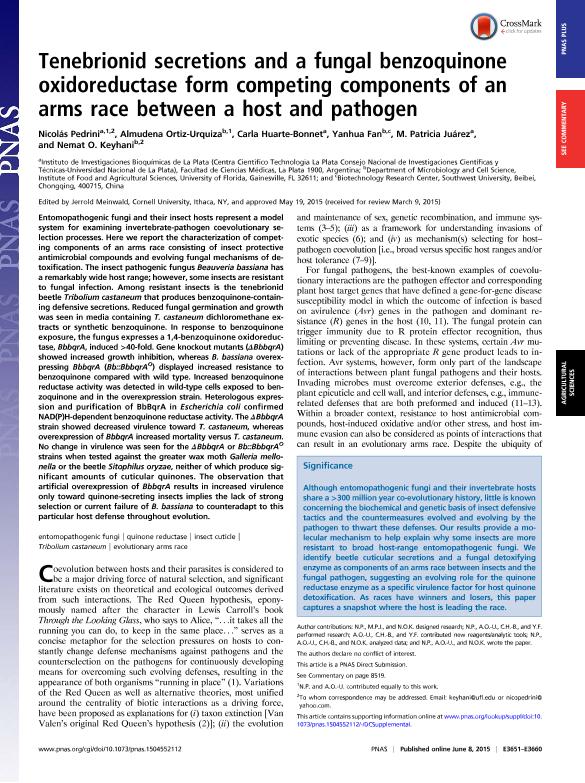Artículo
Tenebrionid secretions and a fungal benzoquinone oxidoreductase form competing components of an arms race between a host and pathogen
Pedrini, Nicolás ; Ortiz Urquiza, Almudena; Huarte Bonnet, Carla
; Ortiz Urquiza, Almudena; Huarte Bonnet, Carla ; Fan, Yanhua; Juarez, Marta Patricia
; Fan, Yanhua; Juarez, Marta Patricia ; Keyhani, Nemat O
; Keyhani, Nemat O
 ; Ortiz Urquiza, Almudena; Huarte Bonnet, Carla
; Ortiz Urquiza, Almudena; Huarte Bonnet, Carla ; Fan, Yanhua; Juarez, Marta Patricia
; Fan, Yanhua; Juarez, Marta Patricia ; Keyhani, Nemat O
; Keyhani, Nemat O
Fecha de publicación:
06/2015
Editorial:
National Academy of Sciences
Revista:
Proceedings of the National Academy of Sciences of The United States of America
ISSN:
0027-8424
Idioma:
Inglés
Tipo de recurso:
Artículo publicado
Clasificación temática:
Resumen
Entomopathogenic fungi and their insect hosts represent a model system for examining invertebrate-pathogen coevolutionary selection processes. Here we report the characterization of competing components of an arms race consisting of insect protective antimicrobial compounds and evolving fungal mechanisms of detoxification. The insect pathogenic fungus Beauveria bassiana has a remarkably wide host range; however, some insects are resistant to fungal infection. Among resistant insects is the tenebrionid beetle Tribolium castaneum that produces benzoquinone-containing defensive secretions. Reduced fungal germination and growth was seen in media containing T. castaneum dichloromethane extracts or synthetic benzoquinone. In response to benzoquinone exposure, the fungus expresses a 1,4-benzoquinone oxidoreductase, BbbqrA, induced >40-fold. Gene knockout mutants (ΔBbbqrA) showed increased growth inhibition, whereas B. bassiana overexpressing BbbqrA (Bb::BbbqrAO) displayed increased resistance to benzoquinone compared with wild type. Increased benzoquinone reductase activity was detected in wild-type cells exposed to benzoquinone and in the overexpression strain. Heterologous expression and purification of BbBqrA in Escherichia coli confirmed NAD(P)H-dependent benzoquinone reductase activity. The ΔBbbqrA strain showed decreased virulence toward T. castaneum, whereas overexpression of BbbqrA increased mortality versus T. castaneum. No change in virulence was seen for the ΔBbbqrA or Bb::BbbqrAO strains when tested against the greater wax moth Galleria mellonella or the beetle Sitophilus oryzae, neither of which produce significant amounts of cuticular quinones. The observation that artificial overexpression of BbbqrA results in increased virulence only toward quinone-secreting insects implies the lack of strong selection or current failure of B. bassiana to counteradapt to this particular host defense throughout evolution.
Archivos asociados
Licencia
Identificadores
Colecciones
Articulos(INIBIOLP)
Articulos de INST.DE INVEST.BIOQUIMICAS DE LA PLATA
Articulos de INST.DE INVEST.BIOQUIMICAS DE LA PLATA
Citación
Pedrini, Nicolás; Ortiz Urquiza, Almudena; Huarte Bonnet, Carla; Fan, Yanhua; Juarez, Marta Patricia; et al.; Tenebrionid secretions and a fungal benzoquinone oxidoreductase form competing components of an arms race between a host and pathogen; National Academy of Sciences; Proceedings of the National Academy of Sciences of The United States of America; 112; 28; 6-2015; 3651-3660
Compartir
Altmétricas



